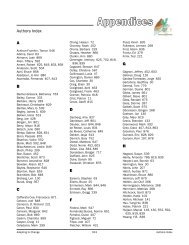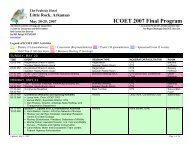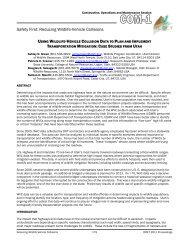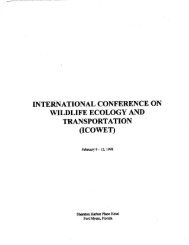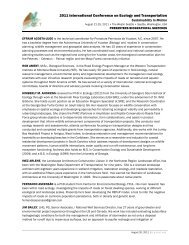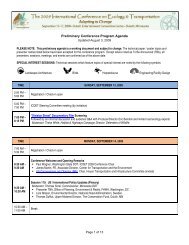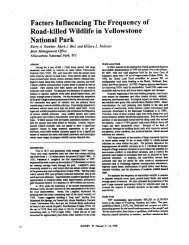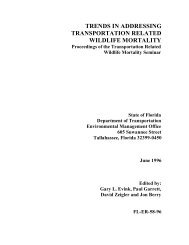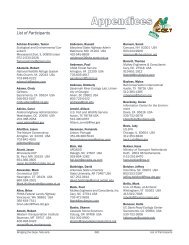Poster Sessions, pages 567-640 - ICOET
Poster Sessions, pages 567-640 - ICOET
Poster Sessions, pages 567-640 - ICOET
You also want an ePaper? Increase the reach of your titles
YUMPU automatically turns print PDFs into web optimized ePapers that Google loves.
Abstract<br />
Lessons and Experiences From a Stream Restoration Project in the Piedmont of North Carolina<br />
Thomas Barrett (919-858-1817, tbarrett@mulkeyinc.com), Senior Scientist/Forester, Mulkey<br />
Engineers and Consultants, Inc., 6750 Tryon Road, Cary, NC 27518 USA<br />
Edward Hajnos, Design and Construction Supervisor, North Carolina Ecosystem Enhancement<br />
Program, 1652 Mail Service Center, Raleigh, NC 27699 USA<br />
Mulkey, Inc. is participating in a stream restoration study with the Ecosystem Enhancement Program in Yadkin County,<br />
North Carolina. The purpose of this study is to restore approximately 4,300 linear feet of Rocky Branch, a second order<br />
stream located in the western Piedmont of North Carolina. Stream restoration in North Carolina is generally conducted<br />
to provide compensatory mitigation for stream impacts from both highway construction and private development.<br />
Since the late 1990s, North Carolina has served at the forefront for stream restoration activities due to the state’s<br />
tremendous population growth and stringent water quality standards. In an effort to provide mitigation for the state’s<br />
needs in an efficient manner, the Ecosystem Enhancement Program was created in 2003 under an agreement with the<br />
North Carolina Department of Environment and Natural Resources, the North Carolina Department of Transportation,<br />
and the U.S. Army Corps of Engineers. There are approximately 400 streams and wetland restoration projects that<br />
are currently under development across 54 watersheds in North Carolina. Those resources having the greatest repair<br />
needs are prioritized and the Ecosystem Enhancement Program works with public and private organizations in an<br />
effort to restore, to enhance and to preserve wetlands, streams, and buffers, statewide. The Ecosystem Enhancement<br />
Program serves as the nucleus for consolidating and streamlining mitigation activities within the state. The project<br />
presented here is one of the many projects this program administers in an effort to meet the ever growing mitigation<br />
needs in the state.<br />
The Rocky Branch site comprises approximately 24 acres of pasture and woodlands immediately adjacent to the<br />
Interstate 77 corridor in Yadkin County, North Carolina. The project site has a drainage area of approximately 3.1<br />
square miles and is part of the South Yadkin River Watershed. The site was once heavily forested, but over the last 100<br />
years has been cleared primarily for pasture and row crops. Cattle have been a significant part of the land-use since<br />
the early part of the 20th century and their impact is highly visible through compaction, erosion, and denuded vegetation<br />
along the stream. The objectives of the Rocky Branch stream restoration project were and continue to be: 1) to<br />
provide mitigation for future needs in the area, 2) to improve water quality by excluding cattle from the stream, 3) to<br />
provide a stable and functional stream channel, 4) to improve the overall quality of the stream and riparian areas and<br />
5) to provide long-term protection of the project through a conservation easement.<br />
The restoration of Rocky Branch’s main channel and its associated tributary were completed using methods based<br />
on the work of David L. Rosgen, PhD, which emphasize the use of natural stability concepts. The stream restoration<br />
project created a new stream channel with the appropriate dimension, pattern, and profile for its specific location<br />
within the watershed. The new channel contains in-stream boulder structures which provide grade control, bank stabilization,<br />
and aquatic habitat. Boulder structures used in conjunction with this project include cross vanes, rock vanes,<br />
and j-hooks. The stream banks were stabilized using erosion control matting, native seed mixes, bare root seedlings,<br />
rootwads, and live vegetation stakes. A permanent riparian buffer was established using native vegetation specific to<br />
the region. Vernal pools were established throughout the riparian buffer to provide habitat, water storage capacity and<br />
micro-topography. To protect the project from disturbance, permanent fencing was established around the entire site.<br />
As is true for projects of this type, an as-built report documenting stream restoration and enhancement is developed<br />
to provide a baseline for future monitoring or success criteria. A monitoring program will be implemented to document<br />
system development and progress toward achieving the success criteria as stipulated in the mitigation requirements<br />
for the project permit. Monitoring will take place over a 5-year period or until final success criteria are achieved.<br />
Bridging the Gaps, Naturally 585 <strong>Poster</strong>s






